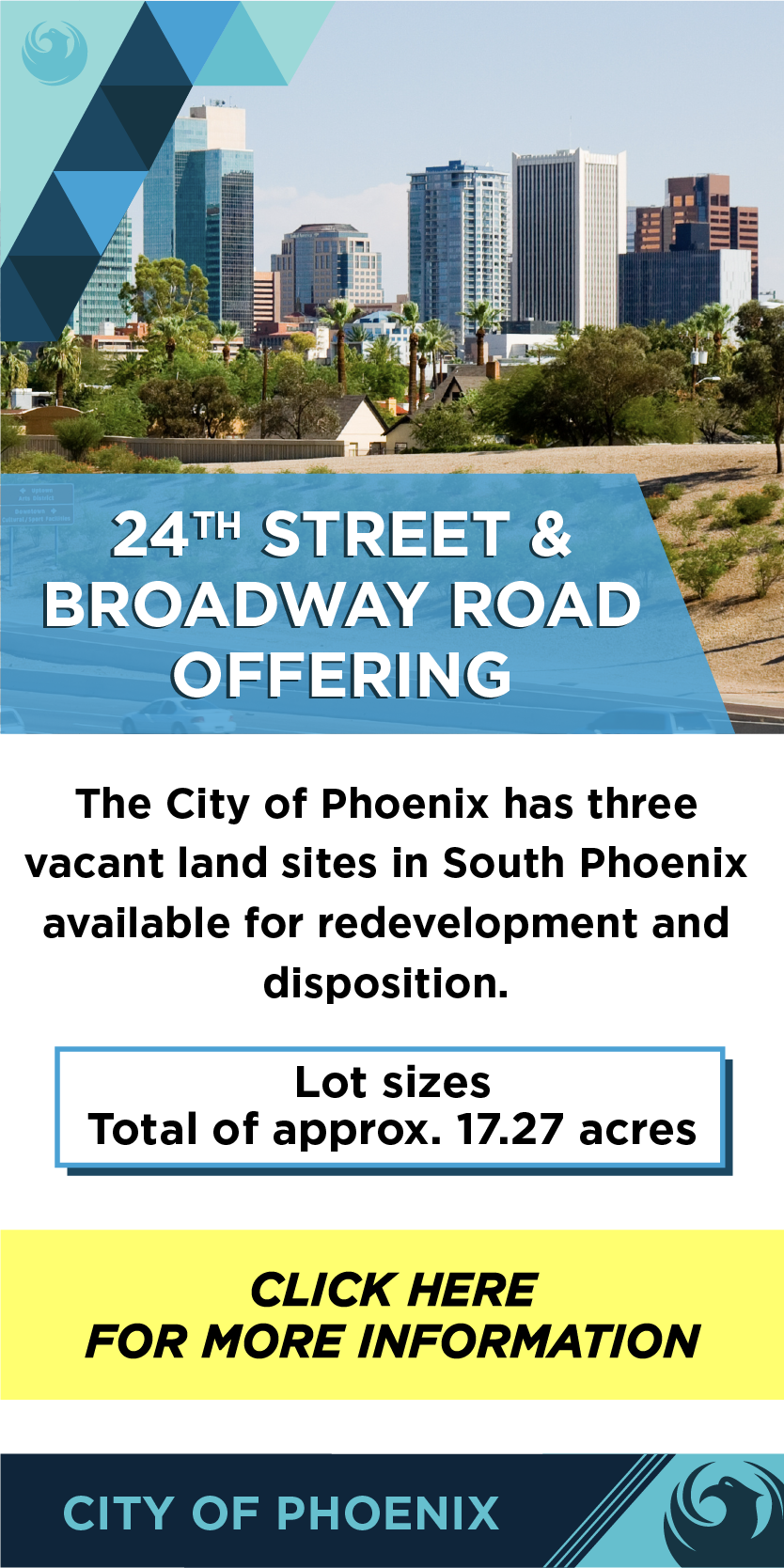An Ohio Suburb's Strategy to Win Business Investments

New Albany, about 15 miles northeast of downtown Columbus, maximizes the planning process to beat major cities in the development sweepstakes.
In the region around Columbus, Ohio, suburbs like New Albany are attracting a remarkable range of businesses, from Fortune 500 headquarters to highly advanced data centers. The 11-county area is one of the most dynamic and diverse metropolitan regions in the United States. In fact, no single industry sector represents more than 18 percent of employment, resulting in a stable economy.
Centrally located between Chicago and New York, the Columbus metropolitan area is within a 10-hour drive of 46 percent of the U.S. population. With nearly 60 colleges and universities nearby, the region produces 20,000 annual graduates and has become a magnet for millennials, a coveted demographic for any workforce.
The success of the 4,200-acre New Albany International Business Park is no accident. This suburb of 10,000 residents successfully competes against major cities thanks to a master plan that leverages public-private partnerships to prioritize the services and amenities that enhance quality of life and quality of work. Updated with input from residents, businesses and other community stakeholders, the plan provides a predictable, prescriptive path forward that helps protect residential and business investment for the long term.
Mastering the Planning Process
Since the city’s first master plan was adopted in 1998, New Albany has created a strong work-life balance with pedestrian-friendly amenities, mixed-use environments, versatile residential choices, quality architecture and ample green space.
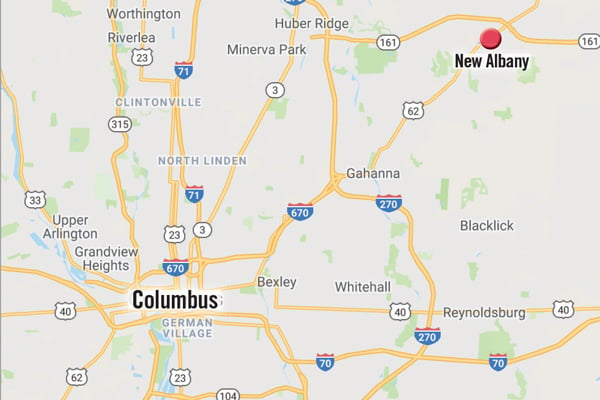
New Albany is conveniently located approximately 15 miles northeast of downtown Columbus, Ohio’s state capital.
Updated every five years, the strategic plan evaluates the existing conditions in the city, identifies developing trends and suggests appropriate land use, transportation and sustainability strategies that allow the city to grow while preserving its character. The city tries to consider every element of the physical environment, from the integrity of the design to visual cues that create a sense of place. The plan also pays close attention to elements that promote human interaction, from neighborhood pocket parks and leisure trails to pedestrian-friendly amenities at its Village Center.
Working closely with MKSK, one of the region’s leading urban planning and design firms, the months-long process entails roundtable discussions with community stakeholders that include residents and neighborhood groups as well as major land holders, civic organizations, businesses, young professionals, chamber members, real estate agents, city staff and elected officials.
Early in the process, a speakers’ series helps build an understanding of the importance of community planning and the specific issues that drive it. At various stages, public workshops, neighborhood gatherings and surveys enable the city to get input and feedback from individuals in the community. Focus groups on specific issues allow planners to drill deeper into attitudes, needs and motivations.
Strategic planning allows New Albany to prioritize community needs, guide public and private development, and allocate city revenue to support service and infrastructure needs while fulfilling the community’s shared vision for the future.
Quality of Life Attracts and Retains Top Talent
From its pedestrian-friendly Market Square with restaurants, cafes and shops to its 45-plus miles of leisure trails and the Heit Center for Healthy New Albany, a state-of-the-art health and wellness center, New Albany appeals to companies that need to attract and retain a skilled talent pool.
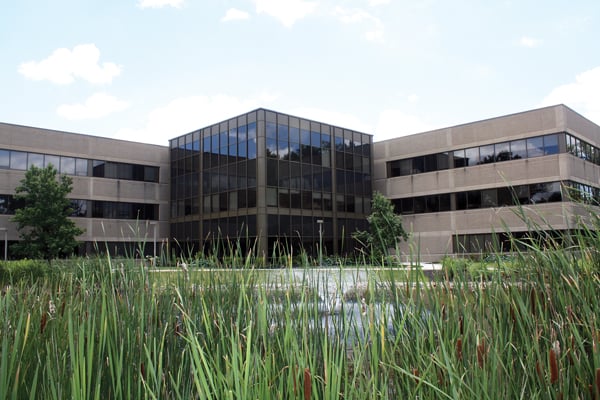
Aetna employs more than 1,300 workers at its facility in the New Albany International Business Park.
Since 2000, the city has grown from 3,700 residents to more than 10,000. Meanwhile, employment at the business park has grown to 15,000. Community planning has played an essential role in managing this growth while staying true to an original vision of a planned community that seeks to employ the best practices of communities like Cotswold, England, while avoiding the pitfalls of post-World War II suburban sprawl.
Additionally, New Albany’s four pillars — education, culture, health and the environment — are reflected in its planning. New Albany’s Village Center is built with important civic amenities, including the library, the New Albany Plain Local Schools’ 200-acre Learning Campus and the McCoy Center for the Performing Arts. Rose Run Park, a new civic green space slated to open later this year, will serve as a “Central Park” that connects the community’s cultural, educational and commercial centers.
Planning Promotes Collaboration, Cooperation
In contrast to typical nondescript suburban office buildings that are surrounded by parking lots, New Albany’s holistic approach ensures that office development preserves open spaces, wooded lots, ponds and other natural features. It also seeks to promote high-quality design and development.
Master planning isn’t a new concept for U.S. business parks. However, the role of business in the strategic planning process has done more than affected the physical space. It has led to a high degree of business connectivity and collaboration that strives to deliver continuous improvement in services by anticipating what businesses will need to succeed in the future and collaborating with them to deliver those services.
For example, New Albany has saved millions of dollars by leveraging public-private partnerships to promote business investment. One prominent example of these collaborative partnerships is the agreement with American Electric Power (AEP). The company originally built its mission-critical transmission center in New Albany, which allowed the city to lease the company’s advanced fiber optic network instead of building its own. Now, the business park is able to offer one of the most advanced fiber optic networks in the country. As AEP continues to build capacity for its customers, the city can offer new businesses the energy and reliability of AEP’s triple-feed electric capabilities, a major competitive advantage in attracting business.
AEP’s robust, high-speed fiber optic network not only helped the community save $7.5 million, it also resulted in a carrier-neutral fiber infrastructure that was among the primary reasons Nationwide Insurance and TJX Companies selected New Albany for their mission-critical facilities after considering other sites across the country. Both companies also received 15-year, 100-percent real property tax abatements.
With the infrastructure and support services needed to help companies grow and expand, New Albany’s business-centric model provides a roadmap for other similar-sized communities looking to attract businesses.
Success Breeds Success When it Comes to Attracting Investments
Since 1998, New Albany has attracted more than $4 billion in private investment, resulting in more than 10.7 million square feet of development, 15,000 jobs and more than $100 million in income tax revenue, according to the New Albany Finance Department. The business park continues to experience growth through business attraction, retention and expansion.
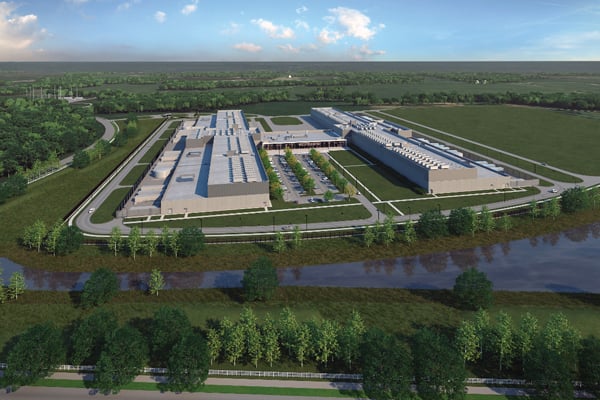
Facebook will invest $750 million to build an advanced, 970,000-square-foot data center in New Albany that will be powered entirely by renewable energy. It’s expected to produce $243.5 million in output along the local economy’s supply chains.
New Albany’s plan and approach to long-term, sustainable development attracts a diverse mix of investment.
For example, Facebook announced plans in 2017 to invest $750 million to construct a technologically advanced, 970,000-square-foot data center powered entirely by renewable energy. A 2017 U.S. Chamber of Commerce study estimates that building a data center of this size will employ up to 1,688 local workers who will receive up to $77.7 million in wages. The construction project will produce $243.5 million in output along the local economy’s supply chains. Once construction is completed, the facility could inject up to $32.5 million into the economy each year.
Now, Google has committed to investing $600 million to build a 280,000-square-foot data center on a 447-acre site.
After building its transmission operations center in New Albany, AEP also invested more than $19 million to complete a 195,000-square-foot transmission headquarters in the park. Aetna, one of the park’s first tenants, announced plans last year to open a second New Albany office and add 350 employees to its current workforce of 1,300. After a nationwide search, Post Consumer Brands decided to keep its newly acquired Bob Evans prepared-foods division in the park. The success of the Personal Care and Beauty Campus has led many of its initial tenants to expand.
Moving at the Speed of Business
Thanks to New Albany’s technology- and shovel-ready commercial sites, fast-track permitting, dedicated weekly open office hours and building walkthroughs, development planning is streamlined.
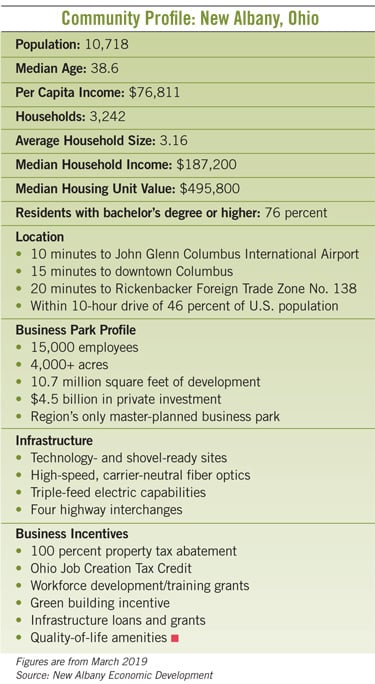
New Albany’s Community Development Department brings together economic development staff, private developers, construction companies, utilities and other stakeholders to ensure that businesses with aggressive timelines can meet them. It builds a schedule for every project so companies know what will happen when and who is responsible, providing both accountability and predictability to the process.
The department dedicates Wednesday mornings to developers and contractors who are at various stages of project implementation, permitting and construction. Having all disciplines available enables companies to get the answers they need quickly and avoid costly delays.
On Thursday mornings, development staff is available to conduct commercial construction walkthroughs and reviews to identify problem areas and provide end users with feedback long before the project goes to final review when delays can derail timeframes and budgets.
According to Ohio State Code, municipalities have 30 days to complete the building permit and review process. New Albany has devised an efficient planning process that completes permitting in less than 21 days — 25 percent faster than many competing communities. The department has condensed the annexation, rezoning and incentives process by nearly two thirds. What previously took nine to 12 months is now accomplished in three and a half months.
In addition to expedited permitting, the city offers sites that are prezoned for commercial use. By working closely with its primary developer and land owner, The New Albany Company, thousands of acres owned by the company have already gone through zoning review, public hearings and city council for approval. This competitive efficiency provides companies with a selection of sites that will not require a lengthy approval process. With zoning in place, The New Albany Company can safely invest in infrastructure and technology even before there is a buyer.
Creating Clusters of Commerce
Another advantage is New Albany’s targeted investment in innovation clusters and campuses. These attract industry leaders seeking an environment that keeps pace with their energy, technology and logistics needs, while creating opportunities for collaboration among park neighbors. The International Business Park features five innovation clusters — Personal Care and Beauty, Information Technology and Mission Critical, Corporate Office and R&D, High-Tech Manufacturing and Logistics, and Healthcare — which help spur partnerships, discovery and commerce.
These companies and the clusters they form represent a major investment within the community. For example, the park’s Information Technology and Mission Critical cluster, which includes Facebook, Google, Discover, Nationwide Insurance and TJX’s Technology Center, accounts for $2.8 billion in private investment alone.
The first of its kind in the nation, the Personal Care and Beauty Campus has quickly attracted global industry leaders by offering turnkey product design, manufacturing, packaging, labeling and distribution within a 200-acre campus. In fact, 15 companies have built nearly 3 million square feet of space at the campus since 2011. New companies like Mast Global–Bath & Body Works joined the campus in 2015, while existing organizations like Axium Plastics have doubled their presence on the campus.
The Benefits of Big Business for Suburbia
Residents continue to benefit from a diversified tax base thanks to the businesses that invest in New Albany. Currently, tax revenue from the business park generates more than 80 percent of the city’s general fund revenues that support services including police protection, road maintenance, leisure trails and snow plowing. Commercial development in the business park has generated $70 million in tax revenue for the award-winning New Albany-Plain Local Schools. Although New Albany has a smaller residential population, local businesses help alleviate some of the tax burden for residents without affecting the quality of services. Businesses in the community have also generously supported civic institutions, including a performing arts center as well as a health and wellness center.
New Albany’s long-term, sustainable plan for investment and development has positioned it to successfully adapt to changes within the modern economic landscape. For other communities hoping to replicate this model, strategic planning, strong public-private partnerships and a collaborative approach to continuous improvement in service delivery are all core components of this living case study.
Jennifer Chrysler is the director of community development for New Albany, Ohio.


